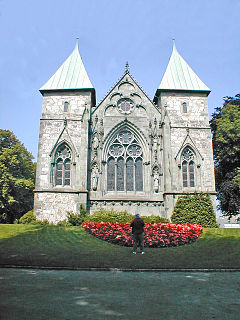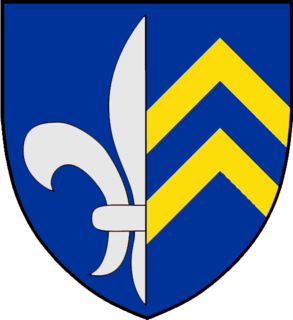
Nidaros Cathedral is a cathedral of the Church of Norway located in the city of Trondheim in Trøndelag county. It is built over the burial site of King Olav II, who became the patron saint of the nation, and is the traditional location for the consecration of new kings of Norway. It was built over a 230-year period, from 1070 to 1300 when it was substantially completed. However additional work, additions and renovations have continued intermittently since then; the most recent changes were completed in 2001. Nidaros was designated as the cathedral for the Diocese of Nidaros in 1152. After experiencing the turmoil and controversies of the Protestant Reformation of the 16th century, it was taken from the Catholic Church by the newly established state Church of Norway in 1537, which adopted the teachings and reforms of Martin Luther, Phillip Melanchthon, and others, becoming an Evangelical Lutheran church. Nidaros is the northernmost medieval cathedral in the world.

Olaf II Haraldsson, later known as Saint Olaf, was King of Norway from 1015 to 1028. Son of Harald Grenske, a petty king in Vestfold, Norway, he was posthumously given the title Rex Perpetuus Norvegiae and canonised at Nidaros (Trondheim) by Bishop Grimkell, one year after his death in the Battle of Stiklestad on 29 July 1030. His remains were enshrined in Nidaros Cathedral, built over his burial site. His sainthood encouraged the widespread adoption of Christianity by Scandinavia's Vikings/Norsemen.
Nidaros, Niðarós or Niðaróss was the medieval name of Trondheim when it was the capital of Norway's first Christian kings. It was named for its position at the mouth of the River Nid.

Jakob Ulvsson was Archbishop of Uppsala, Primate of the Roman Catholic Church of Sweden 1469–1515 and the founder of Uppsala University in 1477.
Eysteinn Erlendsson was Archbishop of Nidaros from 1161 to his death in 1188.

The Archdiocese of Nidaros was the metropolitan see covering Norway in the later Middle Ages. The see was the Nidaros Cathedral, in the city of Nidaros. The archdiocese existed from the middle of the twelfth century until the Protestant Reformation.

Olav Engelbrektsson was the 28th Archbishop of Norway from 1523 to 1537, the Regent of Norway from 1533 to 1537, a member and later president of the Riksråd, and a member of the Norwegian nobility. He was the last Roman Catholic to be the Archbishop of Norway before he fled to exile in 1537.

The former Catholic Diocese of Stavanger in Norway included the modern counties of Rogaland and Agder together with the regions of Valdres and Hallingdal and the parishes of Eidfjord and Røldal from Hordaland. It existed from the beginning of the 12th century to the Protestant Reformation.
The Catholic Diocese of Bergen or Diocese of Bjørgvin in Norway existed from the eleventh century to the Protestant Reformation (1537), and included the (modern) counties of Hordaland and Sogn og Fjordane.

Steinvikholm Castle is an island fortress on the Skatval peninsula near Stjørdal in Trøndelag county, Norway. The castle was built over seven years, from 1525 to 1532, by Norway's last Roman Catholic Archbishop, Olav Engelbrektsson. Steinvikholm castle became a powerful fortification by the time it was built, and it is the largest construction raised in the Norwegian middle age.
Georg Hesler (1427–1482) was a German Roman Catholic cardinal and bishop.

Aslak Harniktsson Bolt was a 15th-century Norwegian priest who served as Archbishop of the Nidaros.
Hans Kruckow was a knight and a royal councilor in Norway.
Henrik Kalteisen, O.P., S.T.D., the Danish and Norwegian name of Heinrich Kalteisen, was a German theologian and, from 1452 to 1458, the 24th Archbishop of Nidaros in Norway.
Marcellus de Niveriis, O.F.M., also known as Marcellus of Skálholt, was a German Franciscan and an adventurer who was the 26th Bishop of Skálholt from 1448 until his death, although he never came to Iceland.
Olav Torkelsson, also known as Olaf Thorkelsön, was the 31st and last Roman Catholic Bishop of Bergen, from 1523 to 1535, and a member of the Riksråd.
Mogens Lauritssøn, also known as Magnus Lauretii, was the 27th and last Roman Catholic Bishop of Hamar.

Aspa is the collective name of both the farm and the group of interrelated Norwegian families of noble origins in Møre og Romsdal, a fylke (county) in southwestern Norway. Several members of this group played significant roles in the political and ecclesiastical history of Norway in the Middle Ages. The group's name comes from its origin, the two farms on the island of Aspøya in the present municipality of Tingvoll, also in Møre og Romsdal – Aspa and Boksaspa.
The history of Christianity in Norway started in the Viking Age in the 9th century. Trade, plundering raids, and travel brought the Norsemen into close contacts with Christian communities, but their conversion only started after powerful chieftains decided to receive baptism during their stay in England or Normandy. Haakon the Good was the first king to make efforts to convert the whole country, but the rebellious pagan chieftains forced him to apostatize. Olaf Tryggvason started the destruction of pagan cult sites in the late 10th century, but only Olaf Haraldsson achieved the official adaption of Christianity in the 1020s. Missionary bishops subjected to the archbishops of Hamburg-Bremen were responsible for the spread of the new faith before the earliest bishoprics were established around 1100.

The Bolt family was an aristocratic family in The Kingdom of Denmark-Norway originating Østfold. Founded in the 14th century, it has spawned aristocratic titles including the Archbishop of Nidaros. The family's first known member is Kolbein Berdorsen at Flesberg in Våler, Østfold. From him descend two linages through the sons Berdor and Aslak.










